Coffee cultivation is a complex process that involves various techniques and methods to ensure the optimal growth and production of coffee beans. From planting to harvesting, each step plays a crucial role in the final quality and flavor of the coffee. In this article, we will explore the journey of coffee from seed to cup and delve into the intricacies of coffee farming.
Welcome to our article on the fascinating world of coffee cultivation! Join us as we take you on a journey from the humble coffee seed to the satisfying aroma and taste of a freshly brewed cup of coffee. We’ll uncover the secrets of coffee farming, exploring the intricate processes and techniques employed by coffee growers around the world. So grab your favorite mug and let’s dive into the captivating world of coffee production!
Key Takeaways:
- Coffee cultivation is a complex process that involves various techniques and methods.
- The two main species of coffee plants are Arabica and Robusta, each with its own unique characteristics and flavors.
- Climatic factors such as temperature, rainfall, and altitude play a crucial role in coffee growth.
- Coffee plants are typically grown in shaded nurseries before being transplanted to coffee plantations.
- Shade-grown coffee is known for its superior flavor and quality, but sun-grown coffee is also widely cultivated.
The Coffee Plantation: Where it All Begins
Coffee cultivation starts at coffee plantations, which are large-scale commercial operations located in various regions worldwide. These plantations provide the ideal environment for the growth and production of coffee beans. The two main species of coffee plants are Arabica (Coffea arabica) and Robusta (Coffea canephora), each with its own unique characteristics and flavors. Arabica coffee is primarily grown in Latin America, while Robusta coffee is predominant in Africa, although both species are also cultivated in other Asian countries.
The climatic factors play a crucial role in coffee growth. The temperature range between 73 and 82 °F (23 and 28 °C) is ideal for coffee cultivation, with a minimum temperature of 32 °F (0 °C) being detrimental to the plants. Coffee plants also require a significant amount of rainfall, typically between 60 and 80 inches (1,500 to 2,000 mm) per year, along with a dry period for Arabica coffee. Altitude is also an important factor, as Arabica coffee thrives at higher elevations of 600–2,000 meters (2,000–6,500 feet) in cooler subtropical climates, while Robusta coffee can grow at lower altitudes.
The coffee plantations serve as the foundation of the coffee production process, providing the perfect conditions for coffee plants to thrive and produce high-quality beans. It is here that coffee farmers employ various cultivation techniques and management practices to ensure optimal growth and production, ensuring the journey from seed to cup is a success.
Climatic Factors and Coffee Growth
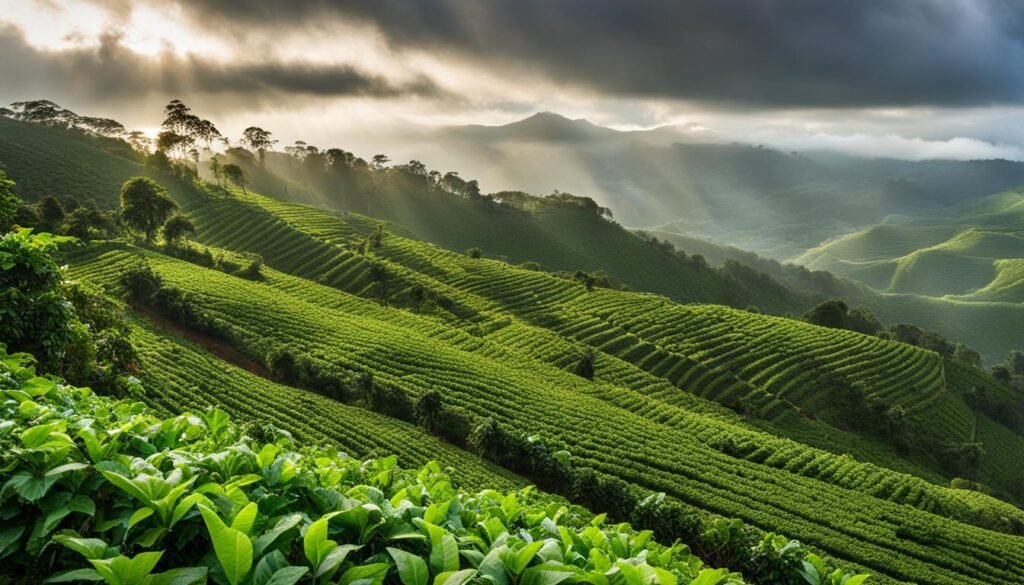
Coffee cultivation is heavily influenced by various climatic factors that play a crucial role in determining the growth and quality of coffee plants. Understanding these factors is essential for coffee farmers to make informed decisions and implement effective cultivation techniques. Let’s explore the key climatic factors that contribute to the successful growth of coffee.
Temperature:
The temperature range is an important factor in coffee cultivation. Coffee plants thrive in a subtropical climate with temperatures between 73 and 82 °F (23 and 28 °C). Extreme temperatures, especially frost below 32 °F (0 °C), can be detrimental to the plants. The right temperature ensures optimal growth and development, resulting in high-quality coffee beans.
Rainfall:
Coffee plants require a significant amount of rainfall to grow properly. The ideal rainfall range for coffee cultivation is between 60 and 80 inches (1,500 to 2,000 mm) per year. This consistent moisture is crucial for the plants to flourish. Additionally, coffee plants need a dry period of two to three months, especially for Arabica coffee, to stimulate flower formation and ensure a successful harvest.
Altitude:
The altitude at which coffee is grown also plays a significant role in its growth and flavor. Arabica coffee thrives in cooler subtropical climates at higher elevations of 600–2,000 meters (2,000–6,500 feet) above sea level. The cooler temperatures at higher altitudes result in slower maturation of the coffee cherries, allowing for greater complexity and acidity in the flavor profile. Robusta coffee, on the other hand, can tolerate lower altitudes.
Challenges and Management:
The climatic factors required for coffee growth pose challenges for coffee farmers, especially in regions with unpredictable weather patterns. To overcome these challenges, farmers employ various management techniques, such as irrigation systems to ensure sufficient water supply during dry periods and implementing shade-grown coffee methods to mitigate extreme weather conditions. Proper management and cultivation techniques are essential to optimize coffee growth and production.
| Climate Factors | Ideal Range | Impact on Coffee Growth |
|---|---|---|
| Temperature | 73-82 °F (23-28 °C) | Optimal growth and development |
| Rainfall | 60-80 inches (1,500-2,000 mm) per year | Provides necessary moisture for growth |
| Altitude | 600-2,000 meters (2,000-6,500 feet) above sea level | Affects flavor profile and maturation |
Coffee Planting and Establishment
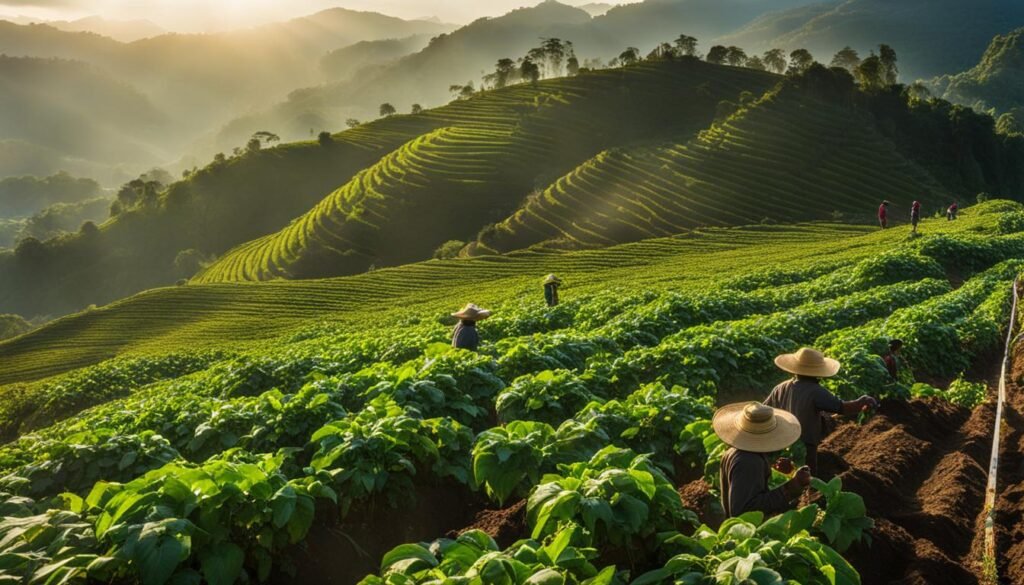
Once the coffee seeds have been carefully nurtured in shaded nurseries, they are ready to be planted in the coffee plantation. The planting process usually takes place at the beginning of the rainy season, ensuring the young coffee seedlings have ample water to establish their roots. Coffee plants are typically planted in large beds, allowing for easy maintenance and monitoring.
The density of coffee plants per hectare can vary between 1,200 and 1,800 plants, depending on the specific requirements of the plantation. Coffee farmers pay close attention to creating a strong framework for the young plants, training them to grow vertically and spreading their branches evenly. This careful management promotes healthy growth and facilitates the process of fruiting.
It takes approximately three to four years for coffee plants to reach maturity and start producing fruits. During this time, coffee farmers continue to provide regular care, including watering, fertilization, and protection against pests and diseases. The establishment phase of coffee cultivation requires patience and expertise, as it sets the foundation for a successful coffee harvest in the future.
The Importance of Proper Planting Techniques
Proper planting techniques are crucial for the successful establishment of coffee plants. One common technique is to dig a hole large enough to accommodate the young coffee seedling while ensuring the roots are spread out evenly. The hole is then filled with a mixture of nutrient-rich soil and organic matter to provide the necessary nutrients for the growing plant.
Another technique is staking, which involves supporting the young coffee plant with a stake to ensure it grows straight and upright. This helps prevent the plant from developing a leaning or crooked trunk, which could affect its overall stability and productivity.
Coffee farmers also consider the spacing between the plants to optimize sunlight exposure and air circulation. Proper spacing allows each coffee plant to receive adequate sunlight and reduces the risk of disease transmission between plants.
Key Takeaways
- Coffee plants are carefully planted in shaded nurseries and then transferred to the coffee plantation.
- The density of coffee plants per hectare can vary, typically ranging from 1,200 to 1,800 plants.
- Proper care, including watering, fertilization, and pest control, is essential during the establishment phase.
- Planting techniques such as staking and proper spacing contribute to the successful growth and development of coffee plants.
| Notable Points | Details |
|---|---|
| Coffee Planting Process | – Young coffee seedlings are carefully planted at the beginning of the rainy season. – Coffee plants are typically planted in large beds. – The density of coffee plants per hectare varies between 1,200 and 1,800 plants. – Proper care, watering, and protection are essential during the establishment phase. |
| Planting Techniques | – Proper planting techniques ensure the even distribution of roots and nutrient-rich soil. – Staking helps support the young coffee plant and promotes upright growth. – Proper spacing optimizes sunlight exposure and reduces disease transmission. |
| Timeline | – Coffee plants take approximately three to four years to start producing fruits. – Regular care and maintenance continue during the establishment phase to promote healthy growth. |
The Art of Coffee Roasting
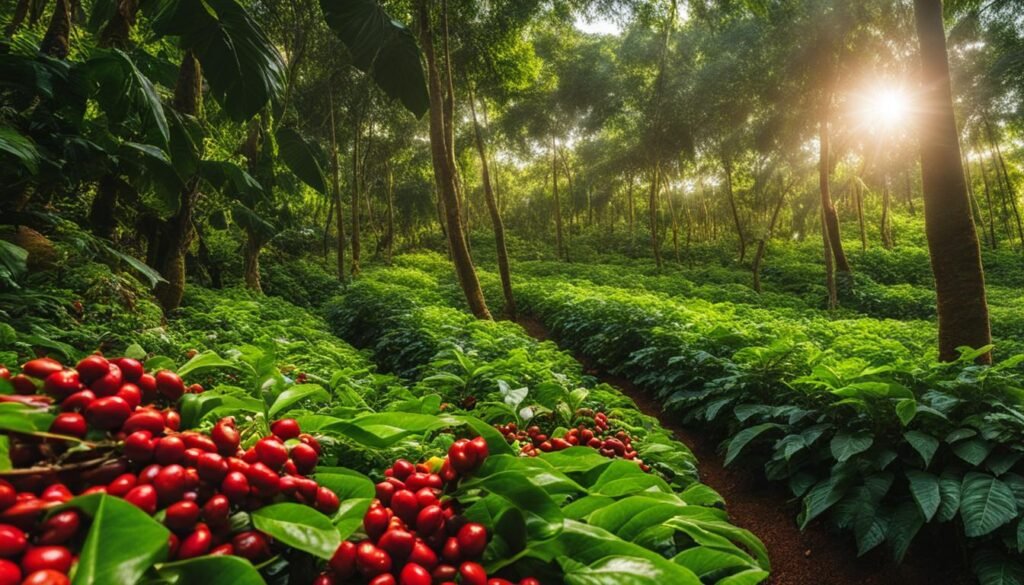
Roasting is a crucial step in the coffee production process that transforms green coffee beans into the aromatic brown beans we use for brewing. It is a delicate and precise art that requires expertise and attention to detail. The roasting process involves carefully monitoring the temperature and time to achieve the desired roast level, which can range from light to medium to dark, each offering a unique flavor profile. The roaster’s skill lies in unlocking the full potential of each coffee bean, capturing its inherent flavors and qualities while balancing acidity, body, and aftertaste.
During the roasting process, a series of complex chemical reactions take place within the coffee beans. As the temperature rises, the beans undergo physical and chemical changes that result in the characteristic flavors and aroma of coffee. The first stage is known as the “drying phase,” where the moisture within the beans is evaporated. This is followed by the “Maillard reaction,” where sugars and amino acids react, creating flavors and aromas reminiscent of caramel, chocolate, and roasted nuts. Finally, the beans enter the “pyrolysis phase,” where the sugars caramelize, and oils within the beans are released, contributing to the rich and robust flavors of dark-roasted coffee.
The Roast Levels and Their Characteristics:
| Roast Level | Characteristics |
|---|---|
| Light Roast | Light brown color, subtle flavors, higher acidity, and floral aroma. |
| Medium Roast | Medium brown color, balanced flavors, moderate acidity, and aroma with notes of chocolate and nuts. |
| Dark Roast | Dark brown to almost black color, bold flavors, lower acidity, and pronounced smoky and bitter notes. |
The choice of roast level greatly influences the final taste of the coffee. Light roasts showcase the delicate nuances of the coffee beans, while medium roasts strike a balance between acidity and body. Dark roasts offer a bold and intense flavor profile, often preferred by those who appreciate a more robust and bitter cup of coffee. The art of coffee roasting lies in finding the perfect balance between roast level, time, and temperature to bring out the desired flavors and create a memorable coffee experience.
Roasters play a crucial role in the coffee industry by sourcing high-quality green coffee beans, experimenting with different roast profiles, and ensuring consistency in flavor and quality. Their expertise and passion for coffee contribute to the diverse range of flavors and experiences that coffee lovers enjoy worldwide. So, the next time you savor a cup of coffee, take a moment to appreciate the artistry and craftsmanship behind the beans, brought to life by the skillful hands of coffee roasters.
Diseases and Pests that Affect Coffee Plants
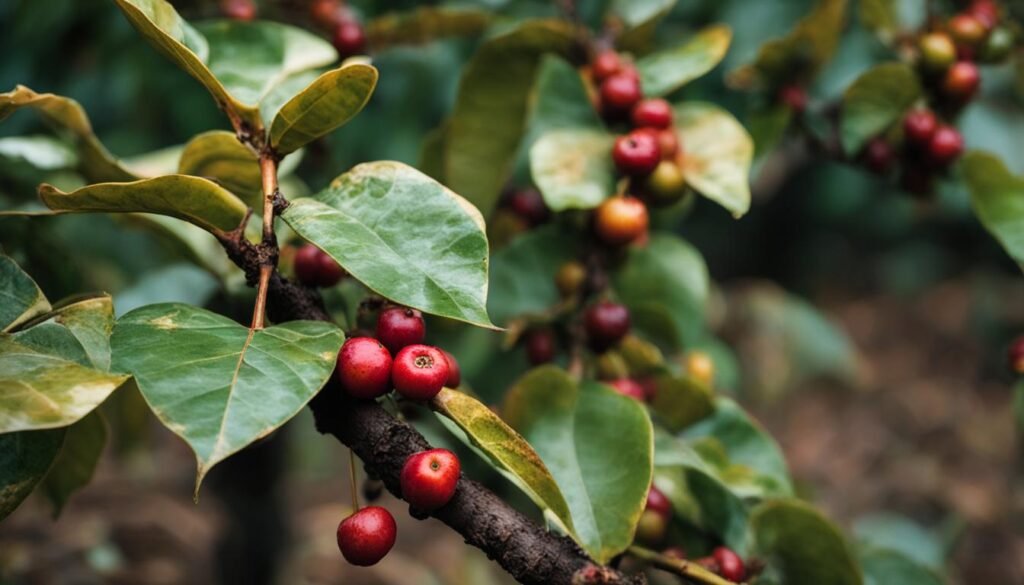
Coffee plants are susceptible to various diseases and pests that can significantly impact their growth and production. One of the most common diseases that affect coffee plants is coffee leaf rust, caused by the fungus Hemileia vastatrix. This disease primarily affects Arabica coffee plantations and can cause severe defoliation, leading to reduced yields and lower-quality coffee beans. Another disease that coffee plants may encounter is coffee berry disease, caused by the fungus Colletotrichum coffeanum. This disease affects both Arabica and Robusta coffee plants and can result in the rotting of berries, ultimately reducing the quantity and quality of the harvested coffee beans.
In addition to diseases, coffee plants also face various pests that can cause significant damage. One such pest is the coffee berry borer, a small beetle that infests coffee cherries and damages the seeds. This pest not only reduces the yield of coffee beans but also affects the flavor and quality of the harvested crop. Arabica coffee is particularly vulnerable to diseases and pests compared to Robusta coffee. Robusta coffee is known for its higher resistance to coffee leaf rust and the coffee berry borer, making it a more suitable choice for regions with higher disease and pest pressure.
Table: Common Coffee Plant Diseases and Pests
| Disease/Pest | Cause | Impact |
|---|---|---|
| Coffee Leaf Rust | Fungus – Hemileia vastatrix | Defoliation, reduced yields, lower-quality beans |
| Coffee Berry Disease | Fungus – Colletotrichum coffeanum | Rotting of berries, quantity, and quality reduction |
| Coffee Berry Borer | Beetle – Hypothenemus hampei | Infestation, damage to seeds, reduced yield, flavor, and quality impact |
Managing and controlling these diseases and pests requires a combination of preventive measures and integrated pest management strategies. Coffee farmers often implement cultural practices such as pruning, proper shade management, and maintaining good field hygiene to minimize disease and pest pressure. Additionally, biological control methods, such as the introduction of natural predators or parasites, can help manage specific pests. Regular monitoring and early detection of diseases and pests are crucial to implementing appropriate control measures and mitigating the potential damage they can cause.
By addressing the challenges posed by diseases and pests, coffee farmers can protect their crops and ensure the long-term sustainability of coffee production. It is essential to stay vigilant and proactive in implementing effective disease and pest management strategies to maintain the health and productivity of coffee plants, ultimately producing high-quality coffee beans for consumers to enjoy.
The Coffee Harvest: From Tree to Bean
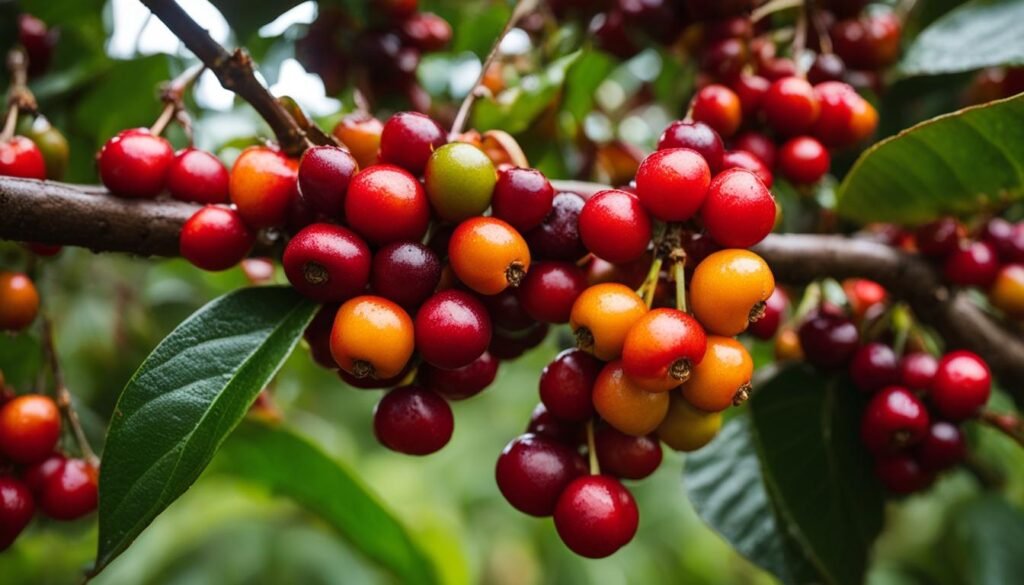
Harvesting coffee cherries is a crucial step in the production process that determines the quality and flavor of the final brew. The cherries are harvested when they reach full ripeness, typically turning a vibrant red color. There are two main methods of harvesting: strip picking and selective picking.
In strip picking, all the cherries on a branch are stripped off at once, regardless of their level of ripeness. This method is efficient but can result in a mix of underripe and overripe cherries, affecting the overall quality of the batch. Selective picking, on the other hand, involves handpicking only the fully ripe cherries individually. This method requires more labor but ensures that only the highest quality cherries are selected, leading to a superior cup of coffee.
Once the cherries have been harvested, they undergo various post-harvest processing methods. The two most common methods are the dry method and the wet method. In the dry method, the cherries are spread out in the sun to dry, allowing the outer skin and pulp to be easily removed. On the other hand, the wet method involves pulping the cherries to remove the skin and pulp, followed by a fermentation process that helps to break down any remaining sugars. After fermentation, the cherries are washed and then dried.
Comparing the Dry and Wet Processing Methods:
| Processing Method | Advantages | Disadvantages |
|---|---|---|
| Dry Method |
|
|
| Wet Method |
|
|
Both processing methods have their advantages and disadvantages, and the choice of method depends on factors such as climate, available resources, and desired flavor profiles. Regardless of the method used, the goal is to remove the outer layers of the cherry and expose the coffee bean, which will undergo further processing and roasting to create the perfect cup of coffee.
The Drying and Milling of Coffee Beans
Once the coffee cherries have been processed, the coffee beans enter the crucial stage of drying. In the dry method, the beans are spread out in the sun to reduce their moisture content. This process can take up to several weeks and requires careful monitoring to ensure even drying and prevent mold or other damage. Alternatively, the wet method involves fermenting the beans and then washing them before they are dried. This method helps to maintain the beans’ acidity and can result in a brighter flavor profile.
After the drying process is complete, the coffee beans move on to the milling stage. This involves removing the outer layers of the beans to reveal the prized coffee seeds within. The first step in milling is hulling, which removes the parchment layer that surrounds the beans. The beans are then polished to remove any remaining silver skin, resulting in smooth and uniform coffee beans ready for further processing.
Once the beans have been dried and milled, they are graded and sorted based on factors such as size, weight, and quality. This grading process ensures that only the finest quality beans make it to market, while lower-grade beans may be used for other purposes. The sorted beans are then carefully packaged and stored until they are ready for export to coffee roasters around the world.
| Method | Description |
|---|---|
| Dry Method | The beans are sun-dried to reduce moisture content. |
| Wet Method | The beans are fermented, washed, and then dried. |
Coffee Bean Storage and Grading
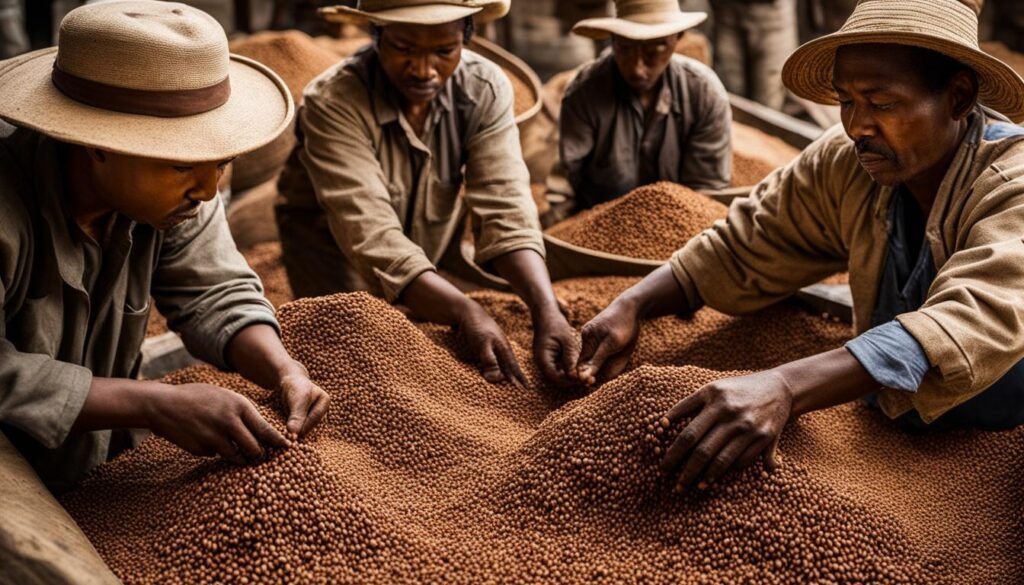
Proper storage and grading of coffee beans are essential to preserve their quality and ensure they meet the desired standards for the market. Coffee beans are vulnerable to various factors such as moisture, heat, and light, which can affect their flavor and freshness. To maintain their optimal characteristics, coffee beans should be stored in well-ventilated places with controlled temperature and humidity levels.
When the coffee beans have been processed and milled, they are referred to as green coffee. It is crucial to store green coffee beans in airtight bags that provide protection from air and moisture. These bags are typically made of jute or sisal material, which allows for proper airflow while preventing the entry of excess moisture. Additionally, storing green coffee beans away from strong odors or substances that could impact their flavor is vital.
Grading is another important aspect of the coffee bean industry. It involves evaluating the characteristics of green coffee beans to determine their quality and value. Grading considers factors such as bean size, weight, color, and defects. Coffee beans are typically categorized into different grades, often designated by a combination of letters and numbers, to indicate their quality. This grading system allows for consistency and transparency in the coffee market, ensuring that consumers and coffee professionals can make informed choices.
Table: Coffee Bean Grading Scale
| Grade | Description |
|---|---|
| AA | Large, evenly shaped beans with no visible defects |
| A | Medium-sized beans with few minor defects |
| B | Small beans with more defects than AA and A grades |
| C | Smaller, lower-quality beans with noticeable defects |
The grading scale may vary depending on the coffee-producing country or region, but it generally provides an indication of the quality and value of the coffee beans. Higher-grade beans are often associated with superior flavor profiles and are sought after by specialty coffee roasters and enthusiasts.
In conclusion, proper storage and grading of coffee beans are crucial steps in preserving their quality and ensuring they meet the desired standards. By implementing appropriate storage methods and following standardized grading practices, the coffee industry can maintain the integrity of the beans and provide consumers with a diverse range of high-quality coffee options.
The Art of Coffee Tasting
Tasting coffee goes beyond taking a simple sip. It is an art form that allows us to explore the intricate flavors and nuances that each coffee bean possesses. Through the process of cupping, we can evaluate the aroma, taste, and overall quality of the coffee, guiding us in selecting the finest beans for a truly exceptional cup of coffee.
During coffee cupping, we carefully assess the aroma of freshly ground coffee, taking note of its fragrances and complexities. We then proceed to taste the coffee, allowing it to coat our palate and analyzing its acidity, body, and aftertaste. Each element contributes to the overall flavor profile, providing us with valuable insights into the coffee’s characteristics.
As we indulge in the coffee’s flavors, we embark on a sensory journey, exploring the different notes and nuances that make each cup unique. The flavors can range from fruity and floral to nutty and chocolatey, offering a delightful array of tastes to experience. Through this process, we are able to identify the qualities that make a particular coffee exceptional and distinguish it from others.
The coffee tasting process involves the following steps:
- Grind a small sample of coffee beans and evaluate the aroma
- Prepare hot water and pour it over the coffee grounds
- Allow the coffee to steep and develop for a specific duration
- Break the crust formed on top of the cup to release the aromas
- Slurp the coffee, allowing it to spread across the palate and coat the taste buds
- Note the flavors, acidity, body, and aftertaste
- Repeat the process with different samples to compare and contrast
Coffee tasting is not only an integral part of the coffee industry but also a delightful experience for coffee enthusiasts. It allows us to appreciate the complexity and craftsmanship that goes into producing a truly exceptional cup of coffee. So, the next time you savor your morning brew, take a moment to appreciate the artistry and dedication that brings that coffee to your cup.
| Flavor Profile | Description |
|---|---|
| Fruity | Exhibits fruity notes such as berries, citrus, or tropical fruits |
| Floral | Offers delicate floral aromas and flavors like jasmine or lavender |
| Nutty | Provides hints of nuts, such as almond or hazelnut |
| Chocolatey | Indulges with rich and smooth chocolate flavors |
| Spicy | Presents warm and exotic spices like cinnamon or cloves |
| Herbal | Features herbal and earthy nuances such as mint or thyme |
The Art of Coffee Roasting
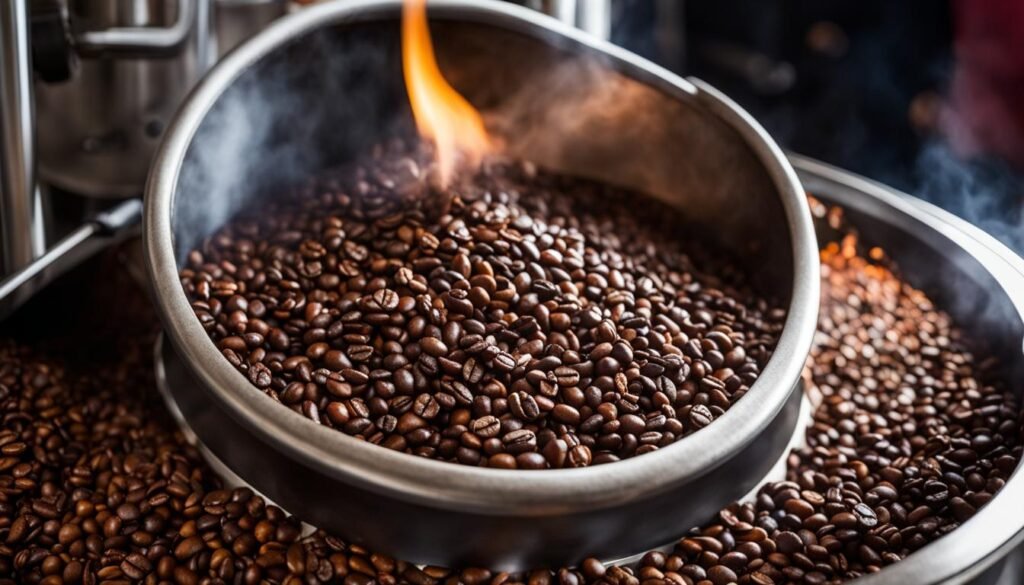
Roasting is a vital step in the coffee production process, where green coffee beans are transformed into the aromatic brown beans that we use for brewing. It is during this stage that the flavors and aromas of coffee are developed. Roasting is done at high temperatures, typically around 550 degrees Fahrenheit, and requires careful monitoring of time and temperature to achieve the desired roast level.
The roasting process is an art form that requires skill and expertise. Expert roasters use their knowledge and experience to bring out the best in each coffee bean, creating unique flavor profiles. From light roasts that showcase the coffee’s origin flavors to dark roasts that bring out rich and smoky notes, there is a wide range of roast levels to explore and enjoy.
Roasting coffee is a combination of science and intuition. As the beans heat up, they undergo physical and chemical changes that affect their taste and aroma. The Maillard reaction, which occurs during roasting, is responsible for the delicious flavors and aromas that we associate with coffee. It is the careful balance of time, temperature, and bean characteristics that allows roasters to achieve the desired flavor profile.
| Roast Level | Color | Flavor Profile |
|---|---|---|
| Light | Light brown | Delicate and bright with pronounced acidity |
| Medium | Medium brown | Balanced flavors with medium acidity |
| Dark | Dark brown | Rich and bold with low acidity |
Roasting coffee is a true art form that requires expertise and a passion for quality. It is the final step in the coffee production process that brings out the full potential of the beans and allows us to enjoy the rich and complex flavors that coffee has to offer.
The Maillard Reaction: Unlocking Flavor and Aroma
The Maillard reaction is a complex chemical reaction that occurs during coffee roasting. It is responsible for the delicious flavors and aromas that develop in the beans.
- The Maillard reaction occurs when amino acids and reducing sugars combine under high heat, resulting in the browning of the coffee beans.
- This reaction produces hundreds of different compounds, including furans, pyrroles, and pyrazines, which contribute to the unique flavors and aromas of roasted coffee.
- The Maillard reaction is influenced by factors such as temperature, time, and bean moisture content, and roasters carefully control these variables to achieve the desired flavor profile.
Understanding the Maillard reaction is crucial for roasters, as it allows them to manipulate the flavors and aromas of the coffee beans. By adjusting the roast level and duration, roasters can create different flavor profiles, ranging from light and fruity to dark and chocolatey. It is this careful balance of science and artistry that makes coffee roasting a truly fascinating process.
Conclusion
As we conclude our exploration of the coffee production process, we are reminded of the intricate journey that coffee beans take from seed to cup. It is a journey that involves the dedication and expertise of coffee farmers, who carefully nurture the plants and navigate the challenges of climate, diseases, and pests.
From the coffee plantations where the coffee plants thrive under suitable climatic conditions, to the meticulous planting and establishment of the seedlings, every step is crucial in ensuring the growth and development of the coffee beans. The cultivation techniques employed and the choice between shade-grown and sun-grown coffee yield different flavors and qualities, adding to the diversity of coffee options available.
Once the coffee cherries are harvested, the post-harvest processing methods of either the dry method or wet method play a pivotal role in shaping the final flavor profile of the coffee. The drying and milling stages further refine the coffee beans, ensuring that only the finest quality beans are prepared for export.
Lastly, the art of coffee tasting and roasting brings out the full potential of the coffee beans, allowing us to savor the unique flavors and aromas that each cup offers. The journey from seed to cup is a testament to the passion and dedication of all those involved in the coffee industry. So, let us raise our cups and appreciate the art and science behind producing the perfect cup of coffee.
FAQ
What are the main climatic factors for coffee growth?
Coffee plants require a temperature range of 73-82 °F (23-28 °C), a minimum temperature above 32 °F (0 °C), and an annual rainfall of 60-80 inches (1500-2000 mm) with a dry season of 2-3 months (Arabica coffee).
What is the difference between Arabica and Robusta coffee?
Arabica coffee is mainly grown in Latin America, while Robusta coffee is predominant in Africa. Arabica is delicate, flavorful and requires higher altitude, while Robusta is more robust, bitter and can grow at lower altitudes.
How are coffee cherries harvested?
Coffee cherries are harvested when they are fully ripe and turn a bright, deep red color. They can be harvested through strip picking, where all cherries are stripped off at once, or selectively picking, where only the ripe cherries are harvested individually.
What is the difference between the dry and wet methods of coffee processing?
In the dry method, coffee cherries are sun-dried, then the outer skin and pulp are removed. In the wet method, the cherries are pulped to remove the skin and pulp, then they undergo fermentation, washing, and drying.
How are coffee beans graded and sorted?
After drying, the coffee beans go through the milling process, which includes hulling to remove the parchment layer and polishing to remove any remaining silver skin. The beans are then graded and sorted based on size, weight, and quality to meet the desired market standards.
What is the purpose of coffee cupping?
Coffee cupping is a process of evaluating coffee quality by analyzing aroma, taste, and overall flavor profile. It allows roasters and coffee professionals to select the best beans for specific blends or roasts, resulting in a diverse range of coffee flavors and experiences.
How does coffee roasting impact the flavor of the coffee?
Coffee roasting at high temperatures plays a significant role in developing the flavors and aromas of the coffee. The roast level can range from light to dark, each offering a unique flavor profile. Expert roasters master the art of roasting to bring out the best in each coffee bean.
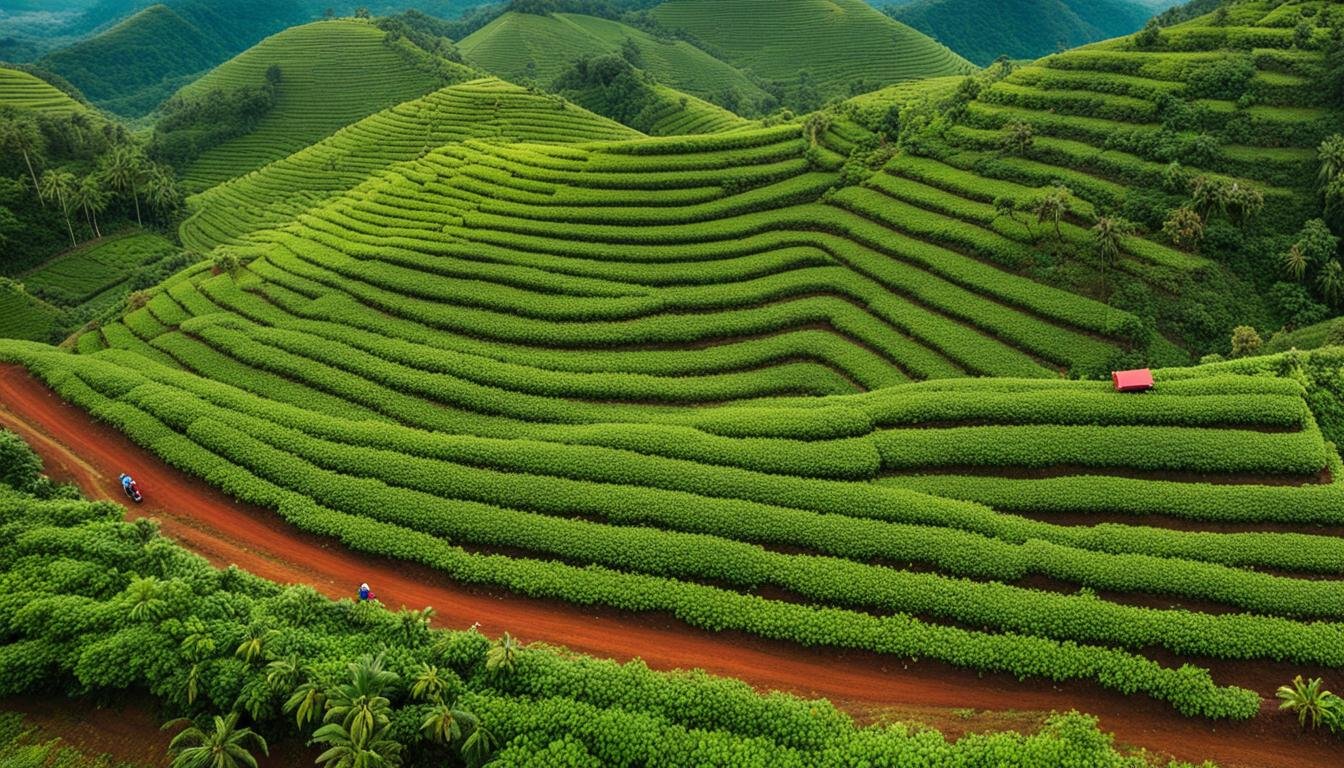
Leave a Reply